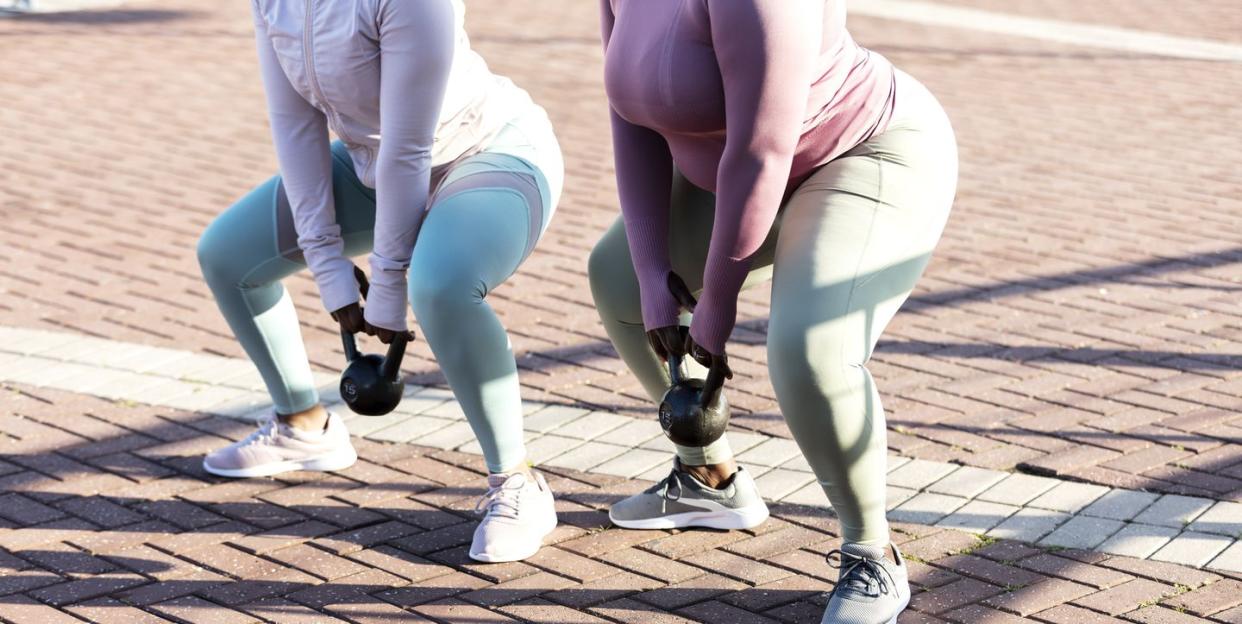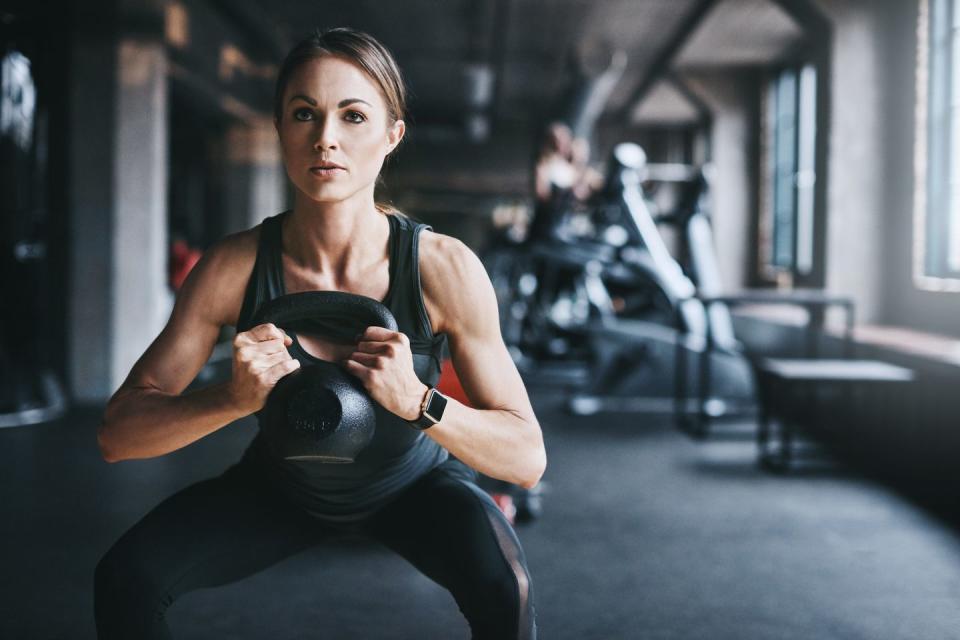Goblet Squats Are the Simple, Muscle-Building Exercise Your Fitness Routine Needs

One of the best butt-sculpting workouts is a squat, but with so many different variations, it can be tricky to find one that effectively lifts and tones your glutes. “Squats are a great lower body workout for all fitness levels,” says Daniel Saltos, certified personal trainer and founder of Train with Danny.
But for those with back pain, traditional squats can feel like too much. Trying out a variation like a goblet squat, though, can help you get all of that lower body love with less impact.
What is a goblet squat?
A goblet squat is a full-body exercise that involves performing a squat while holding a single free weight, such as a kettlebell or dumbbell, in front of the chest. This beginner-friendly workout not only works the glutes, quads, and calves, but it also strengthens the core and upper arms to build strength all over. Best of all, it’s much easier on the lumbar than a barbell squat.
“While squatting with a barbell, the weight is resting on the shoulders and upper back, which puts tension on the spine,” Saltos says. “Because of the wider stance and weight in the front, goblet squats help protect the spine, making them a good workout for those with back and knee pain.”
Goblet squat benefits
As with all squats, goblet squats help strengthen the lower body, including the quads, calves, and glutes. This compound exercise, which targets multiple muscle groups, also tones the core and upper body for a full-body workout.
Goblet squats come with a range of benefits that support the whole body:
More calories burned
Because of its compound nature, goblet squats are a more efficient way to burn more calories in a shorter amount of time. Because you’re working more muscle groups at once, your heart will work harder to pump oxygen to your cells, resulting in an increased amount of calories burned, Saltos says.
Improved posture
This popular exercise improves posture because it reinforces proper mechanics. “Because the weight is in the front, you get more activation in the spinal erectors, thus strengthening them,” Saltos says. Having strong spinal erectors helps support the spinal cord and straightens the back for side-to-side rotation, he adds.

Reduced pain and injury risk
Unlike a traditional squat, which has a more narrow stance, goblet squats requires a wider stance that angles the knees outward. “Because you’re standing wider with your toes angled out, it prevents the knees from caving in,” Saltos says. “Goblet squats also strengthen the muscles that support the knee joint, including the quads, hamstrings, and glutes, which helps prevent the knee from further damage.”
Functional fitness
Goblet squats are a form of functional fitness, meaning they imitate real-life movements such as bending down to pick up the groceries, rising up out of bed, or squatting down to play with the kids. Therefore, they may enhance your ability to perform daily tasks while also preventing injury, Saltos says.
How to do a goblet squat
You can do a goblet squat with or without weight. To perform, stand with your feet slightly wider than hip’s width. Angle your toes out about 45 degrees. While holding a dumbbell or kettlebell (or holding your hands in a prayer shape), cup the weights with your wrists facing inwards, sending your knuckles out to the sides.
Look forward and pull your belly button in towards your spine to engage your core, and keep your eyes looking straight ahead. As you inhale, press your hips back as if you were sitting in a seat to squat down. If you’re using weight, keep the weight at your chest as you lower, and make sure your weight is in your heels and your chest is upright. In the squat, your elbows should be positioned inside your knees.
On an exhale, drive through your heels to stand, and squeeze your glutes at the top to further engage your muscles. If you’re not using weights, try 12 to 15 reps for a set of three, Saltos says. Those using heavier weights can aim for 8 to 12 reps for a set of three. Doing this exercise twice a week should allow you to reap all of the glute-strengthening benefits.

Common goblet squat mistakes
Although this exercise is pretty simple to perform, there are still mistakes that can occur, impacting your muscle-building ability and possibly leading to injury. “The biggest mistakes are regarding proper form and alignment,” Saltos says.
Common mistakes while performing a goblet squat may include:
Holding the weight too far in front
Sometimes people hold the dumbbell or kettlebell too far in front of them. “This puts strains on your biceps, forearms, and shoulders,” Saltos says. Instead, keep the weight at your chest as you squat down and stand back up.
Buckling the knees in
If your stance is too narrow and your toes aren’t pointed outwards at 45 degrees, then your knees may buckle inwards. “The goal is to make sure the knees are tracking over your toes,” Saltos says. “Angle your feet, stand wider than hip’s width, and place your weight in your heels.”
Leaning forward in the chest
Hinging at the hips can take you out of alignment and puts stress on the back, Saltos says. Instead, place your weight in your heels and gaze straight ahead. “This will help keep you back upright,” he says.
Going too heavy too fast
With any strength training exercise, you’ll want to start with bodyweight or lighter weights until you have the form down. “When the weight is too heavy, the form starts to get compromised, and this takes away from the movement and can lead to injury,” Saltos says. Go lighter so you can focus on form, then once you have it, increase the load.
Who shouldn’t do a goblet squat?
Goblet squats are one of the most beginner-friendly variations of the exercise. “Goblet squats are pretty much safe for everyone,” Saltos says. “If you’re a beginner, consider using no weight or lighter weight, then work up to more weight once you achieve proper form.”
If you are performing goblet squats and begin to experience knee or back pain, consult a fitness expert or your doctor about correcting your form and evaluating if it’s a beneficial exercise for you.
You Might Also Like

